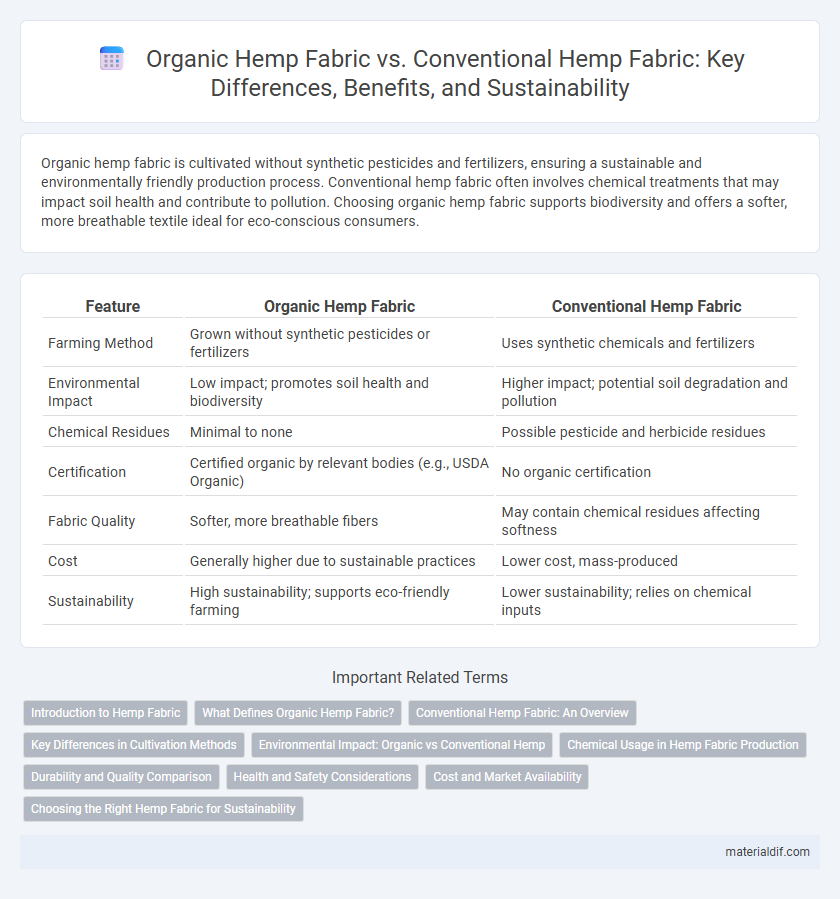Organic hemp fabric is cultivated without synthetic pesticides and fertilizers, ensuring a sustainable and environmentally friendly production process. Conventional hemp fabric often involves chemical treatments that may impact soil health and contribute to pollution. Choosing organic hemp fabric supports biodiversity and offers a softer, more breathable textile ideal for eco-conscious consumers.
Table of Comparison
| Feature | Organic Hemp Fabric | Conventional Hemp Fabric |
|---|---|---|
| Farming Method | Grown without synthetic pesticides or fertilizers | Uses synthetic chemicals and fertilizers |
| Environmental Impact | Low impact; promotes soil health and biodiversity | Higher impact; potential soil degradation and pollution |
| Chemical Residues | Minimal to none | Possible pesticide and herbicide residues |
| Certification | Certified organic by relevant bodies (e.g., USDA Organic) | No organic certification |
| Fabric Quality | Softer, more breathable fibers | May contain chemical residues affecting softness |
| Cost | Generally higher due to sustainable practices | Lower cost, mass-produced |
| Sustainability | High sustainability; supports eco-friendly farming | Lower sustainability; relies on chemical inputs |
Introduction to Hemp Fabric
Hemp fabric, derived from the fibers of the Cannabis sativa plant, is renowned for its durability, breathability, and eco-friendliness. Organic hemp fabric is cultivated without synthetic pesticides or chemical fertilizers, ensuring a cleaner production process that supports soil health and biodiversity. Conventional hemp fabric often involves chemical inputs that may impact environmental sustainability and fabric purity.
What Defines Organic Hemp Fabric?
Organic hemp fabric is defined by its cultivation without synthetic pesticides, herbicides, or chemical fertilizers, ensuring minimal environmental impact and healthier soil conditions. Certified organic hemp must adhere to strict agricultural standards verified by organizations such as the USDA or GOTS, emphasizing sustainable farming practices and non-GMO seeds. This results in fabric that is not only eco-friendly but also free from harmful residues, making it ideal for sensitive skin and sustainable fashion applications.
Conventional Hemp Fabric: An Overview
Conventional hemp fabric is typically produced using synthetic pesticides and fertilizers, which can affect soil health and biodiversity. This production method often relies on mechanized harvesting and chemical retting processes that speed up fiber extraction but may lead to environmental pollution. Despite these concerns, conventional hemp fabric offers consistent quality and lower manufacturing costs, making it widely available in the textile market.
Key Differences in Cultivation Methods
Organic hemp fabric is cultivated using natural fertilizers and pest control methods, avoiding synthetic chemicals to promote sustainable soil health. Conventional hemp fabric relies on chemical pesticides and synthetic fertilizers, which can degrade soil quality and harm surrounding ecosystems. The organic cultivation method enhances biodiversity and results in a textile free of harmful residues, whereas conventional practices often prioritize higher yields at the expense of environmental impact.
Environmental Impact: Organic vs Conventional Hemp
Organic hemp fabric is cultivated without synthetic pesticides and fertilizers, significantly reducing soil contamination and water pollution compared to conventional hemp farming. Conventional hemp often involves chemical inputs that can degrade biodiversity and increase carbon emissions through energy-intensive production processes. Choosing organic hemp fabric supports sustainable agriculture by promoting healthier ecosystems and lowering the overall environmental footprint.
Chemical Usage in Hemp Fabric Production
Organic hemp fabric is produced without synthetic pesticides, herbicides, or chemical fertilizers, resulting in a safer and more environmentally friendly textile. Conventional hemp fabric often involves chemical inputs that can leave residues in the fabric and contribute to soil and water contamination. Choosing organic hemp fabric reduces exposure to harmful chemicals and supports sustainable agricultural practices.
Durability and Quality Comparison
Organic hemp fabric exhibits superior durability due to its natural cultivation processes, which avoid harsh chemical treatments that can weaken fibers. Conventional hemp fabric, while often more affordable, may contain residues from pesticides and synthetic fertilizers that compromise long-term fabric integrity. Quality assessments reveal that organic hemp fabric maintains strength and softness after repeated washes, making it a preferred choice for sustainable, high-performance textiles.
Health and Safety Considerations
Organic hemp fabric is cultivated without synthetic pesticides and herbicides, reducing exposure to harmful chemicals for both farmers and consumers, making it a safer choice for sensitive skin and allergy sufferers. Conventional hemp fabric often involves the use of chemical treatments during cultivation and processing, which can leave residues that potentially irritate skin or trigger allergic reactions. Prioritizing organic hemp supports sustainable agriculture practices and ensures a toxin-free textile ideal for health-conscious individuals and eco-friendly product lines.
Cost and Market Availability
Organic hemp fabric typically commands a higher price due to sustainable farming practices and certification costs that limit mass production. Conventional hemp fabric is more widely available in the market, benefiting from established supply chains and lower cultivation expenses. Buyers seeking eco-friendly options often face a trade-off between cost efficiency and sustainability with organic hemp textiles.
Choosing the Right Hemp Fabric for Sustainability
Organic hemp fabric is cultivated without synthetic pesticides or fertilizers, significantly reducing environmental pollution and promoting biodiversity compared to conventional hemp fabric. Choosing organic hemp fabric ensures lower chemical runoff and healthier soil, aligning with sustainable agricultural practices and supporting eco-friendly textile production. Prioritizing organic hemp fabric contributes to sustainable fashion by minimizing the ecological footprint and encouraging responsible resource use.
Organic Hemp Fabric vs Conventional Hemp Fabric Infographic

 materialdif.com
materialdif.com